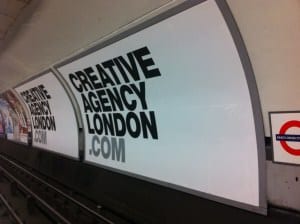How one creative agency got creative with its offline advertising
 If you’ve ever travelled on the London Underground you’ll be well aware of the fact that virtually all space is for sale.
If you’ve ever travelled on the London Underground you’ll be well aware of the fact that virtually all space is for sale.
Over a billion passenger journeys are made every year which, coupled with an average platform wait of three minutes, gives brands an amazing opportunity to engage with a large number of people during their commute.
In fact, according to data from CBS Outdoor, 87% of consumers actually welcome tube advertising as it provides them with a distraction on their journey.
A 'London' voice and engagement measurement
With so many brands competing for space, there is a need to develop a tone of voice that speaks specifically to London commuters. Holiday or dating agency adverts are likely to focus on the convenience of London transport for selling their product.
And how do you measure engagement on the Underground?
Last year a flurry of brands tried to measure engagement using a QR code. However, realisation quickly dawned that a QR code is useless on an underground advert until WI-FI is universally available - measuring Tube campaign impact with a smartphone will just have to wait. So brands must create advertising that is so memorable people will follow up on it once they’re back above ground.
The majority of Tube adverts you’ll see are for B2C consumer products with mass market appeal. So, how can a B2B brand with a need for precision targeting break into this underground space?
Case study: A creative agency cracks Tube advertising
Well, two weeks ago I was standing on the platform at Kings Cross on my way to work and the station announcer had just informed the packed platform that the next train was three minutes away. There was a lot of huffing and puffing from my fellow commuters and I began to look around for distractions. That’s when I noticed this advert:

This advert spoke to me – clearly and simply, using all the right key words. As a marketer I was completely blown away.
I regularly work with agencies and generally engage with them via networking events, cold calls or credential presentations. The minute you see this advert you know the agency is creative and based in London; and you know how to find it ‘.com’.
Most travellers are not going to bat an eyelid at this advert but, when you consider how many marketers a) live in London and b) are always on the lookout for new inspiration for their campaigns, you’ve still got a sizeable demographic to aim at. Although not everyone in the target group will be an immediate buyer, even if they’re only intrigued enough to visit the website that’s ok too; they are now a qualified lead with the potential to be nurtured through to purchasing the agency’s services.
And the best part of this advert – ROI measurement is easy
Why?
Part of the brilliance of this advert is it doesn’t need to feature the agency’s name or an identifying mark. Clinic (www.clinic.co.uk) knows that every single person who visits via the campaign URL www.creativeagencylondon.com has arrived on site as a direct result of seeing its advertising.
My curiosity piqued, I wanted to know more about the agency and how it had come up with the campaign. More importantly, I wanted to find out how successful the campaign had been. I got in touch with Clinic and met up with Directors Guy Hatton and Mark Nicholls over lunch to discuss the campaign impact.
Impressive campaign results
Naturally Guy and Mark weren't prepared to reveal specific figures. However, they were able to tell me website visits increased by 160% in the campaign’s first month; page views increased 700% and the average time visitors spent on the site increased by a few minutes. Obviously Clinic has received enquiries on its work but, I think the most telling aspect of the campaign’s impact is the dramatic increase in CVs the organisation is receiving. Talented creatives are clearly seeing the adverts and thinking “this is the sort of organisation I want to work for”. The organisation no longer needs to go to recruitment agencies to find good people - good people are coming direct to it.
Regarding this campaign’s cost, you might think it is relatively expensive. Mark and Guy feel they've had good value for money from the campaign and that their clients would be over the moon with similar results.
There’s been a little criticism and cynicism within the industry, but I think some of the agency attitudes can be attributed to jealousy rather than genuine criticism. Besides, the advertising campaign is not aimed at the competition - it's aimed at people like me. And I'm sure there are many in my peer group who are sufficiently impressed with the campaign and would love to have this level of creativity applied to their own brand.
Mark and Guy confirmed that the campaign will be running for the rest of the year and evolving over time. I look forward to seeing the next campaign step, demonstrating creativity is alive and well in the agencies of London.

Thanks to
Alan Duncan for sharing his advice and opinions in this post. Alan is a digital strategist at
Tangerine and Black. He specialises in digital marketing project lifecycle management and initiatives designed to increase brand or product awareness in competitive markets. You can connect on
LinkedIn. Alan wrote previously for Smart Insights summarising a
LinkedIn Advertising example.





 Thanks to
Thanks to 



